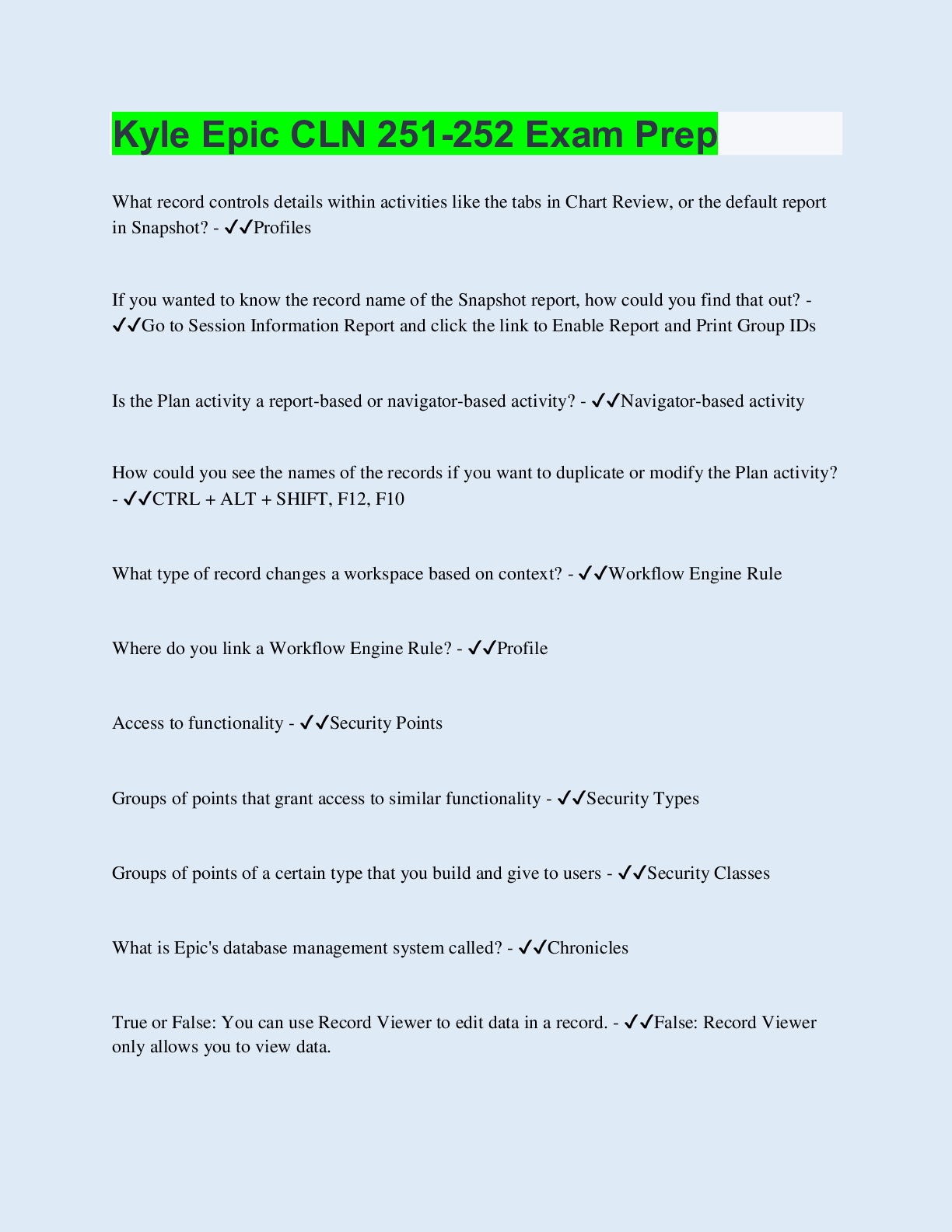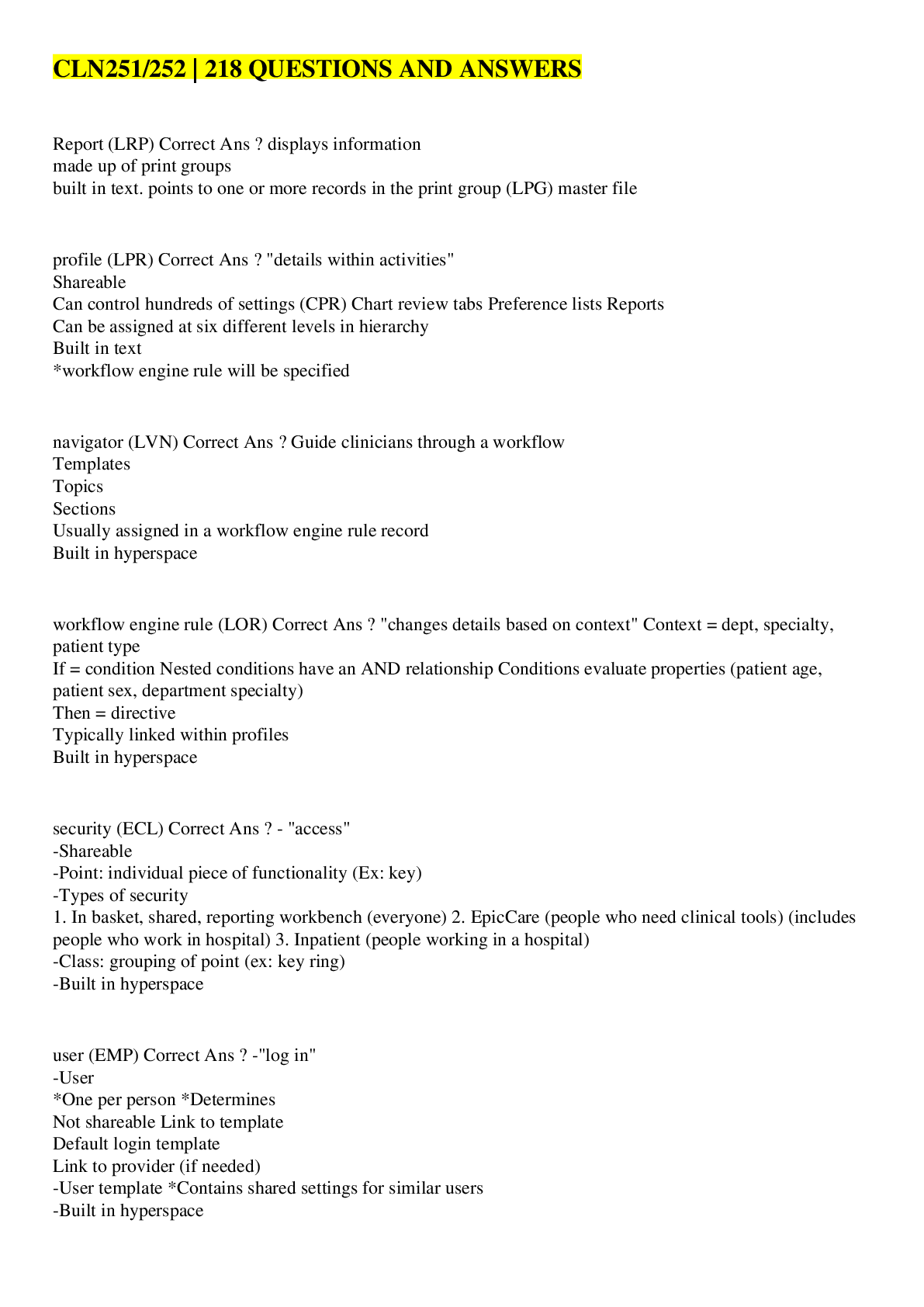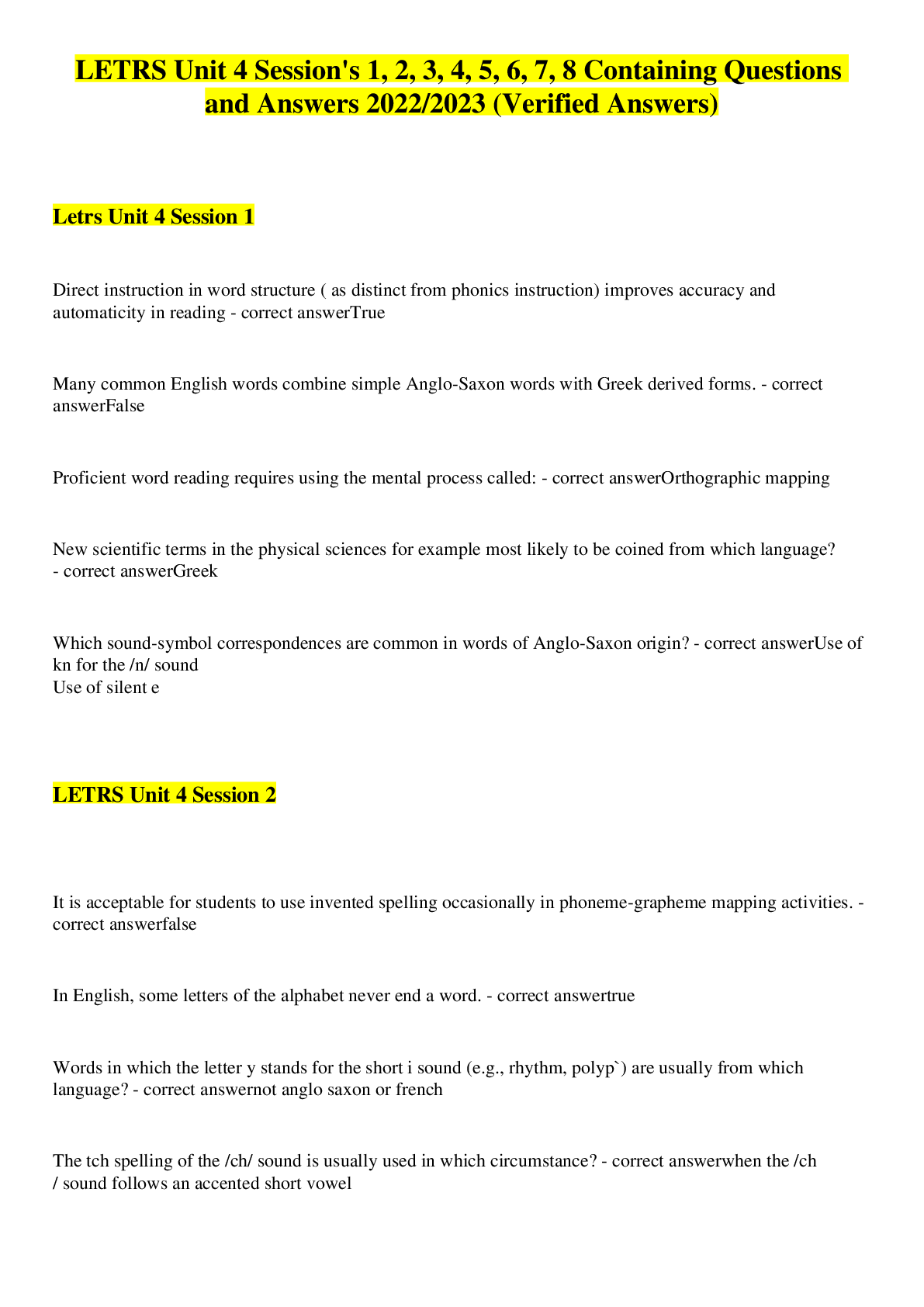*NURSING > EXAM > Nurs 625 Quiz 8 exam questions and answers 2021 marked in yellow new solution (All)
Nurs 625 Quiz 8 exam questions and answers 2021 marked in yellow new solution
Document Content and Description Below
Nurs 625 Quiz 8 exam questions and answers 2021 marked in yellownew solution QUESTION 1 A 7-year-old child has tonsillitis and is prescribed penicillin V, which is to be administe red at home. The ... nurse will instruct the parents to administer the drug A. with a glass of water 1 hour before or 2 hours after a meal. B. intravenously with the assistance of a home health nurse. C. immediately before or with a meal. D. with a sip of water 1 hour before mealtime. 1 points QUESTION 2 Which of the following would a nurse assess for in a patient who is taking polymyxin B systemically? A. Nephrotoxicity and hepatotoxicity B. Hyperkalemia and hyponatremia C. Endocarditis and hypertension D. Peripheral neuropathy 1 points QUESTION 3 A patient is taking rifampin (Rifadin) for active TB. When discussing this drug with the patient, the nurse should stress that A. facial flushing may appear but will go away once therapy is concluded. B. the drug usually causes cardiac arrhythmias. C. the drug frequently causes seizure activity. D. body fluids such as urine, saliva, tears, and sputum may become discolored. 1 points QUESTION 4 A patient is prescribed ganciclovir to treat a CMV infection. An oral dosage is prescribed. To help increase bioavailability of the drug, the nurse will encourage the patient to take the medication A. with high-fat meals. B. on an empty stomach. C. with orange juice. D. with high-protein meals. 1 points QUESTION 5 A 20-year-old female patient is receiving topical clindamycin for acne vulgaris. She develops a rash and urticaria along with severe itching where the medication is applied. The nurse will formulate which of the following nursing diagnoses for the patient? A. Risk for Injury related to allergic reactions B. Diarrhea C. Risk of Injury related to blood dyscrasia D. Imbalanced Nutrition: Less than Body Requirements 1 points QUESTION 6 Mr. Laird is a 49-year-old electrician who experienced severe burns on his trunk, arms, and hands in a workplace accident 2 weeks ago. Part of his current wound care regimen involves the daily application of silver sulfadiazine to his wounds. The nurses who are providing care for Mr. Laird in the burns and plastics unit of the hospital should perform what action when administering this medication? A. Apply a thin layer of the drug to Mr. Laird's wound beds using clean technique. B. Apply a layer of silver sulfadiazine that is sufficiently thick to make the wound bed invisible. C. Cleanse the wound of debris prior to applying the silver sulfadiazine D. Perform thorough wound care immediately after the application of silver sulfadiazine 1 points QUESTION 7 A 72-year-old patient is prescribed ophthalmic ciprofloxacin for a bacterial infection in her right eye. The nurse will teach her to observe for which of the following adverse effects of the drug? A. Nephrotoxicity and neurotoxicity B. Tendon ruptures C. Lid margin crusting and pruritus D. Cognitive changes 1 points QUESTION 8 A nurse has questioned why a patient's physician has prescribed a narrow-spectrum antibiotic rather than a broad-spectrum drug in the treatment of a patient's infection. Which of the following facts provides the best rationale for the use of narrow-spectrum antibiotics whenever possible? A. The use of broad-spectrum antibiotics can create a risk for a superinfection. B. Broad-spectrum antibiotics confound the results of subsequent culture and sensitivity testing. C. The efficacy of most narrow-spectrum antibiotics has not been proven. D. Narrow-spectrum antibiotics normally require a shorter duration of treatment. 1 points QUESTION 9 A 15-year-old patient has meningitis caused by Haemophilus influenzae. She is being treated with chloramphenicol. The most important nursing action for this patient would be to monitor A. urine output daily. B. liver enzymes monthly. C. blood sugar levels daily. D. plasma concentrations regularly. 1 points QUESTION 10 Sulconazole has been prescribed for a patient with tinea pedis. The nurse will instruct the patient to use the topical agent A. as needed. B. three times a day. C. once a day. D. twice a day. 1 points QUESTION 11 Which of the following nursing actions is most important in achieving successful antimicrobial therapy with vancomycin? A. Provide maximum physical comfort to the patient B. Monitor serum drug level C. Taper down the drug dosage gradually D. Promote adequate intake of fluids and nutrients 1 points QUESTION 12 A 49-year-old farmer who normally enjoys good health has become seriously ill in recent days and the results of an extensive diagnostic work up have resulted in a diagnosis of histoplasmosis. The patient has been admitted to the hospital and has begun treatment with amphotericin B. The nurse who is providing care for the patient should prioritize which of the following diagnostic results during his course of treatment? A. Hemoglobin, hematocrit, and red blood cells B. Electrolytes, blood urea nitrogen, and creatinine C. PT, PTT, and platelets D. C-reactive protein 1 points QUESTION 13 An immunocompromised patient in a critical care setting has developed a respiratory infection that has been attributed to methicillin-resistant Staphylococcus aureus (MRSA). The nurse should anticipate that the patient will require treatment with A. an antistaphylococcic penicillin. B. ciprofloxacin. C. vancomycin. D. clindamycin. 1 points QUESTION 14 A child is taking permethrin for head lice. The nurse will instruct her mother to A. wash her hair daily with a good shampoo. B. stop using creams, ointments, and oils on the child's skin and scalp. C. maximize the child's fluid intake. D. increase her daily intake of milk. 1 points QUESTION 15 A nurse is aware that the concept of selective toxicity is foundational to antimicrobial therapy. Which of the following statements most accurately describes selective toxicity? A. A drug's effect on microorganisms is proportionate to dose. B. A drug can be isolated and produced in a controlled manner in a laboratory setting. C. Most microbes may be collected from a host and cultured on an alternative medium. D. A drug harms microbes without harming human cells. 1 points QUESTION 16 A nurse is caring for a patient who is on amphotericin B. On morning rounds the patient reports weakness, numbness, and a tingling sensation in his feet. What would be a priority action by the nurse? A. Encourage the patient to increase fluid intake. B. Use strict aseptic technique for drug administration. C. Keep the bed in a low position and the side rails up at all times. D. Reduce the drug dosage 1 points QUESTION 17 A patient is receiving cefazolin in combination with anticoagulants. To minimize the adverse effects during therapy, the nurse will A. administer the medication with small amounts of food and fluids. B. continue therapy until 2 days after symptoms have resolved. C. monitor the patient for bleeding gums. D. monitor the site of injection. 1 points QUESTION 18 A patient is receiving long-term clindamycin therapy for a life-threatening infection. The nurse will begin by monitoring this drug therapy by obtaining A. a baseline complete blood count. B. establishing the patient's auditory abilities. C. blood glucose levels daily for 1 week. D. liver enzymes weekly until the drug therapy is completed. 1 points QUESTION 19 Which of the following is critical to helping prevent development of resistant strains of microbes in patients? A. Maintain the maximum safe frequency of antimicrobial drug ingestion B. Maintain the optimum duration of the antimicrobial agent C. Limit the exposure of bacteria to an antimicrobial agent D. Keep the antimicrobial drug dosage high 1 points QUESTION 20 A patient has endocarditis and is taking gentamicin. The nurse will be sure to monitor which of the following? A. Serum albumin level B. Prothrombin time C. Creatinine clearance D. Potassium level 1 points QUESTION 21 A patient has been prescribed daptomycin for a complicated skin infection. Which of the following will the nurse advise the patient to report immediately? A. Nausea and vomiting B. Palpitations C. Abdominal pain D. Muscle pain or tingling 1 points QUESTION 22 An immunocompromised patient with a diagnosis of candidiasis has failed to respond to conservative therapy and has consequently begun treatment with amphotericin B. The nurse is aware that this drug achieves a therapeutic effect by way of its influence on A. the permeability of fungal cell walls. B. the osmolarity of fungal intracellular fluid. C. the production and maturation of CD4+ T-cells. D. protein synthesis of fungal cells. 1 points QUESTION 23 A 46-year-old man is receiving a quinupristin/dalfopristin IV infusion for a life-threatening infection. Which of the following would be most important for the nurse to monitor? A. Increased heart rate B. Nausea and vomiting C. Infiltration, edema, or phlebitis at the infusion site D. Breathlessness 1 points QUESTION 24 An immunocompromised cancer patient has developed cryptococcal meningitis and been admitted to the intensive care unit for treatment with amphotericin B. How should the nurse most safely administer this drug? A. Infuse the drug over 2 to 4 hours into a central line using an infusion pump B. Place the patient on a constant infusion of amphotericin B at a rate determined by the patient's body weight. C. Flush the patient's central line with normal saline and infuse the amphotericin B by intravenous push over 5 to 7 minutes. D. Hang the drug by piggyback with lactated Ringer's and infuse over several hours to minimize the risk of infusion reaction 1 points QUESTION 25 A 30-year-old woman who is in the first trimester of pregnancy has presented to her primary care provider with a 4-day history of a reddened, itchy left eye that is crusted with purulent exudate. The clinician suspects a bacterial, rather than viral, etiology. How will the patient's pregnancy affect the potential use of ciprofloxacin to treat her conjunctivitis? A. It is safe for the patient to use topical ciprofloxacin but the oral route is potential teratogenic. B. The use of ciprofloxacin is contraindicated in pregnancy. C. The patient will require a lower dose and longer course of ciprofloxacin than a nonpregnant, adult patient. D. Ciprofloxacin is safe to use in pregnancy and the patient may use to same dose and route as a nonpregnant patient. 1 points QUESTION 26 A patient has been admitted to the critical care unit with a diagnosis of peritonitis that has necessitated treatment with gentamicin. As a result, the care team should be cautious when concurrently administering other medications that may cause A. neutropenia or autoimmune effects. B. increased intracranial pressure or changes in cognition. C. anemia or impaired erythropoiesis. D. ototoxicity or nephrotoxicity. 1 points QUESTION 27 A 45-year-old female patient is prescribed ciprofloxacin to treat a bronchial infection. A nursing assessment revealed that she started taking daily vitamin supplements about 2 years ago. To maximize the therapeutic effects of the ciprofloxacin therapy, the nurse should advise the patient to A. take the vitamins at least 2 hours before or after taking ciprofloxacin. B. reduce the dosage of vitamin supplements and double the dosage of ciprofloxacin. C. alternate the dosage of ciprofloxacin and vitamin supplements. D. reduce the dosage of vitamin supplements. 1 points QUESTION 28 A patient is being treated for Mycoplasma pneumoniae pneumonia. She is allergic to penicillin and is being given azithromycin (Zithromax) in capsule form. The nurse will inform the patient that she will need to take the capsule A. with food. B. with or without food. C. on an empty stomach. D. immediately after she eats. 1 points QUESTION 29 A nurse is instructing a colleague on how an antimicrobial produces a therapeutic effect. Which of the following should be included in the nurse's teaching? A. Penicillin interferes with synthesis of the bacteria cell wall. B. Selective toxicity determines the appropriate drug dosage needed. C. The first drugs used to treat infections date back to the 17th century. D. Fluoroquinolones interfere with the growth and development of the bacteria cell wall. 1 points QUESTION 30 A 43-year-old man has been diagnosed with active TB. He is prescribed a multiple drug therapy, including INH and rifampin. A priority assessment by the nurse will be to monitor which combination of laboratory test results? A. Thyroid-stimulating hormone, thyroxine, and triiodothyronine levels B. Serum alanine transaminase, aspartate transaminase, and bilirubin C. Red blood count, white blood count, and differential D. Fasting blood sugar and 2-hour postprandial blood sugar 1 points QUESTION 31 A 15-year-old boy is being carefully monitored for a skin infection and is being given ciprofloxacin. The nurse will observe for which of the following? A. Hypotension B. Arthropathy C. Colitis D. Hepatitis 1 points QUESTION 32 Laboratory testing has confirmed that a patient has chloroquine-resistant malaria and the patient's physician has prescribed quinine along with an adjunctive drug. The nurse should question the physician's order if the patient has a history of A. cardiac arrhythmias. B. osteoporosis or low bone density. C. diabetes mellitus. D. chronic obstructive pulmonary disease (COPD). 1 points QUESTION 33 A patient with AIDS has developed a number of secondary infections in recent weeks, including Kaposi's sarcoma. As a result of this most recent diagnosis, his care team has opted to begin treatment with interferon alfa-2a. The nurse is aware that this drug will address the etiology of Kaposi sarcoma by A. potentiating the effects of phagocytes and macrophages. B. increasing the production of B cells and T cells. C. causing mutations in the DNA of cancerous cells. D. inhibiting tumor growth by enhancing inflammation. 1 points QUESTION 34 A 30-year-old African-American woman tested positive for TB and is prescribed isoniazid. The nurse will plan the patient's care to include close monitoring of the drug therapy because A. the therapeutic effect of the drug may be too slow to be effective. B. the patient is at greater risk for high serum levels of the drug. C. the process of drug metabolism may be faster in this patient. D. the process of drug elimination will be faster in this patient. 1 points QUESTION 35 A 34-year-old male has been diagnosed with TB and will be started on INH therapy. The medication history reveals that he currently takes antacids on a regular basis. The nurse will instruct the patient to take A. antacids during the day and INH only at night. B. INH before meals and antacids 1 or 2 hours after meals. C. antacids before meals and INH 1 or 2 hours after meals. D. antacids not less than 1 hour before or 2 hours after taking INH. [Show More]
Last updated: 1 year ago
Preview 1 out of 8 pages
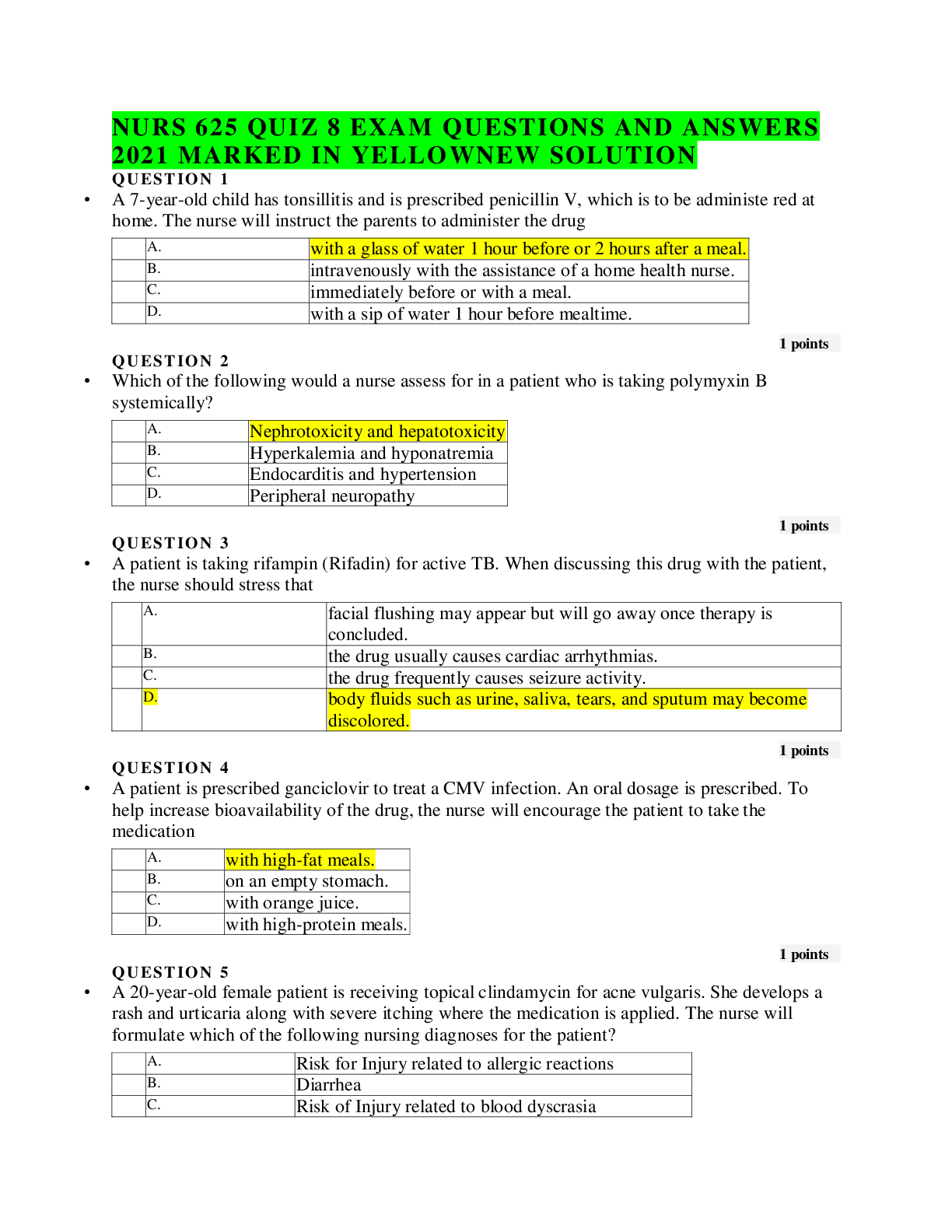
Reviews( 0 )
Document information
Connected school, study & course
About the document
Uploaded On
Feb 27, 2021
Number of pages
8
Written in
Additional information
This document has been written for:
Uploaded
Feb 27, 2021
Downloads
0
Views
29

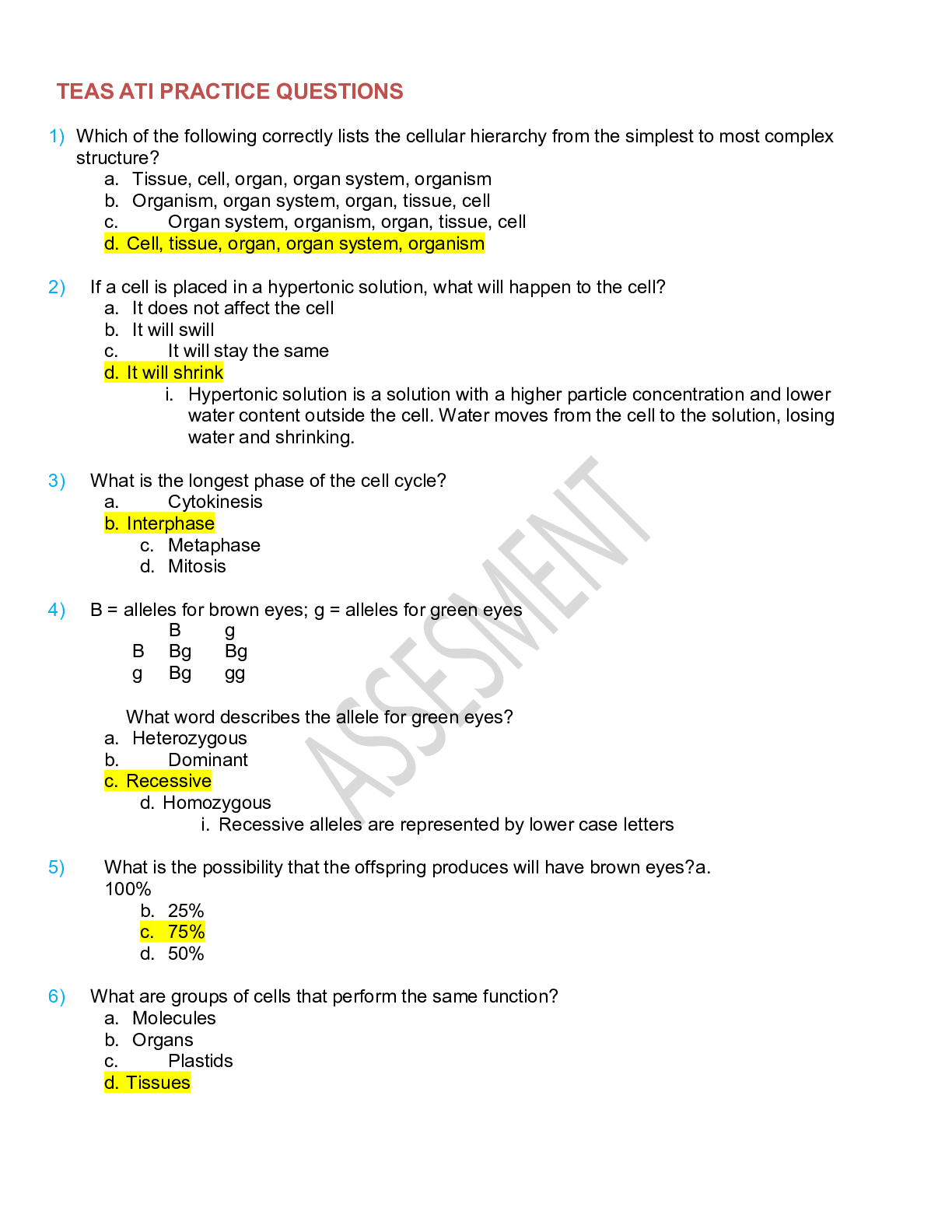
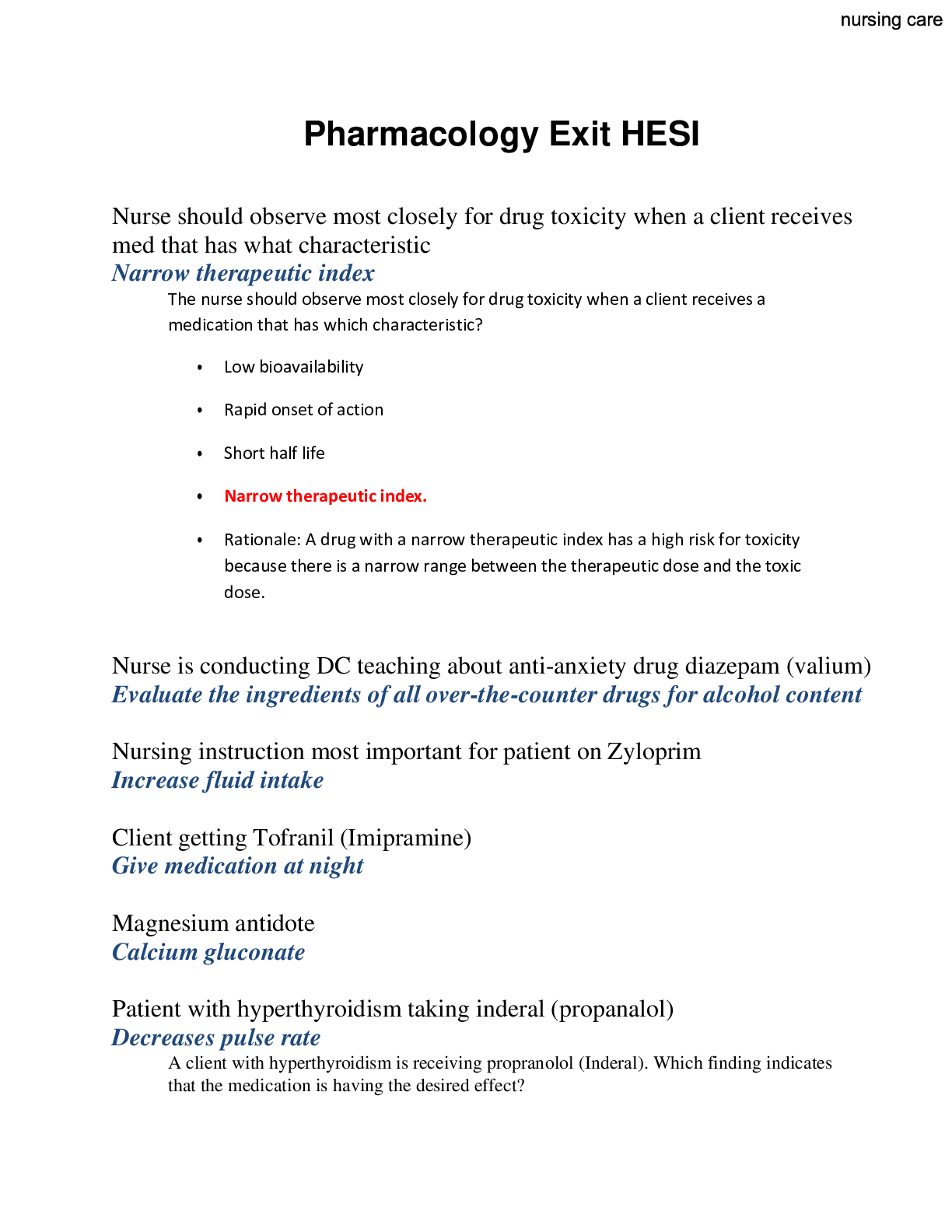

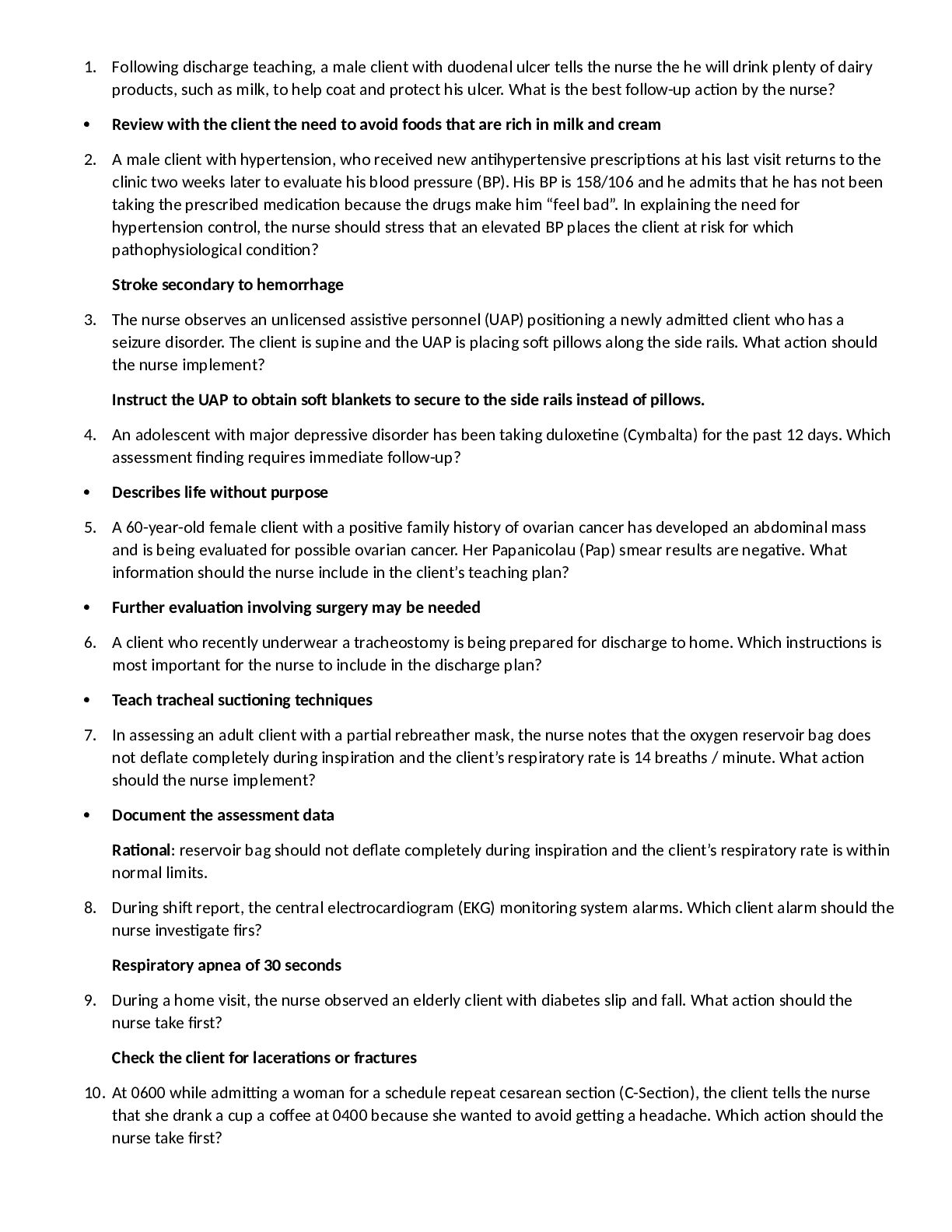
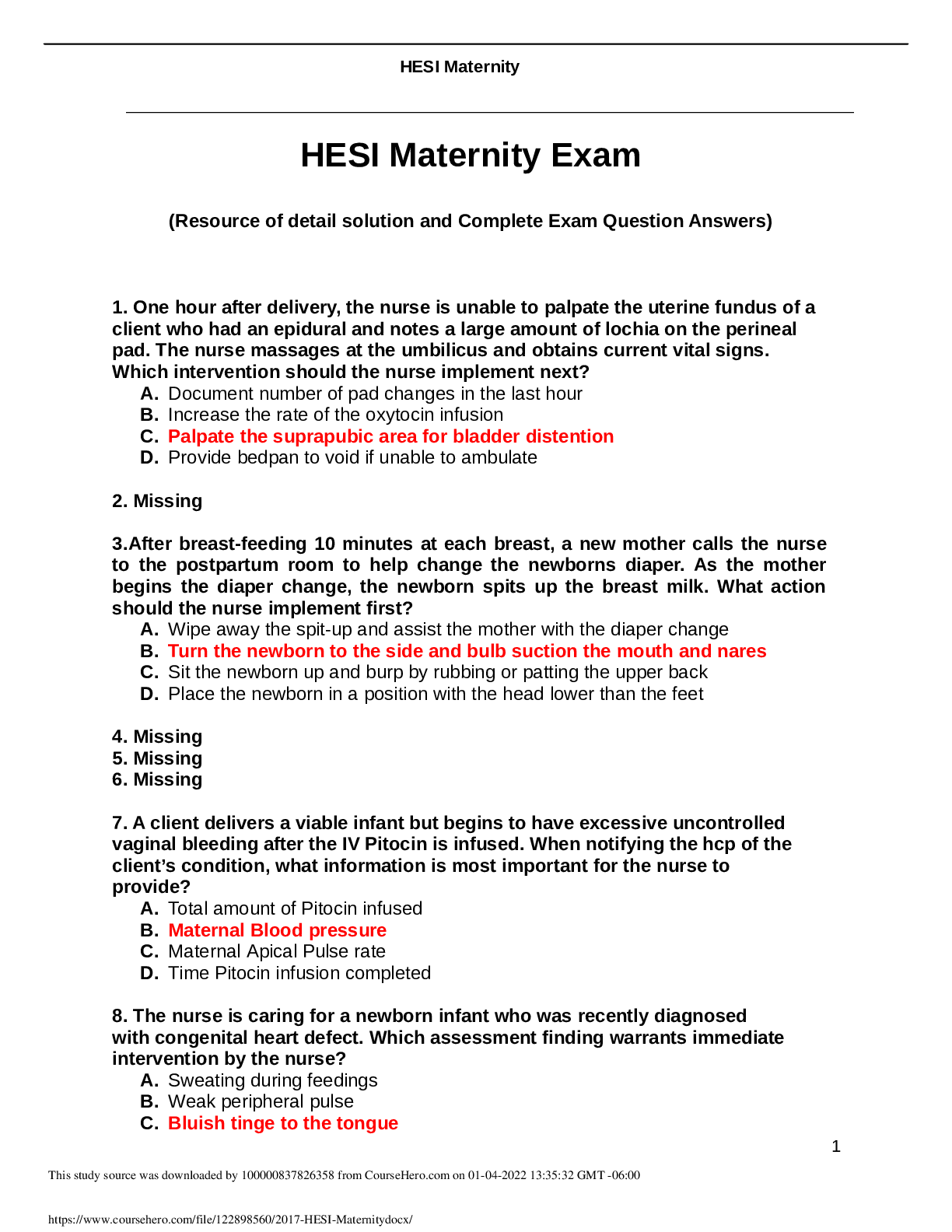
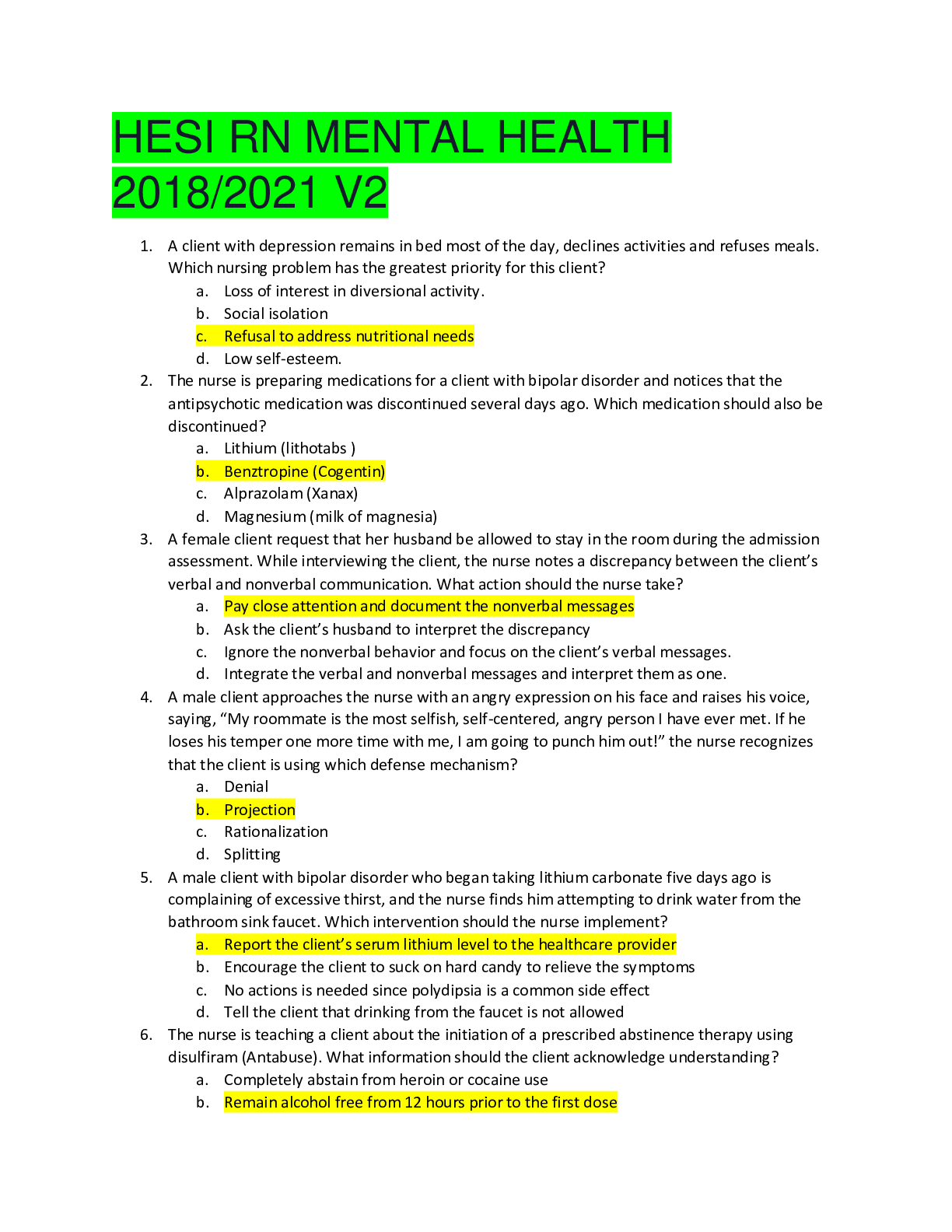

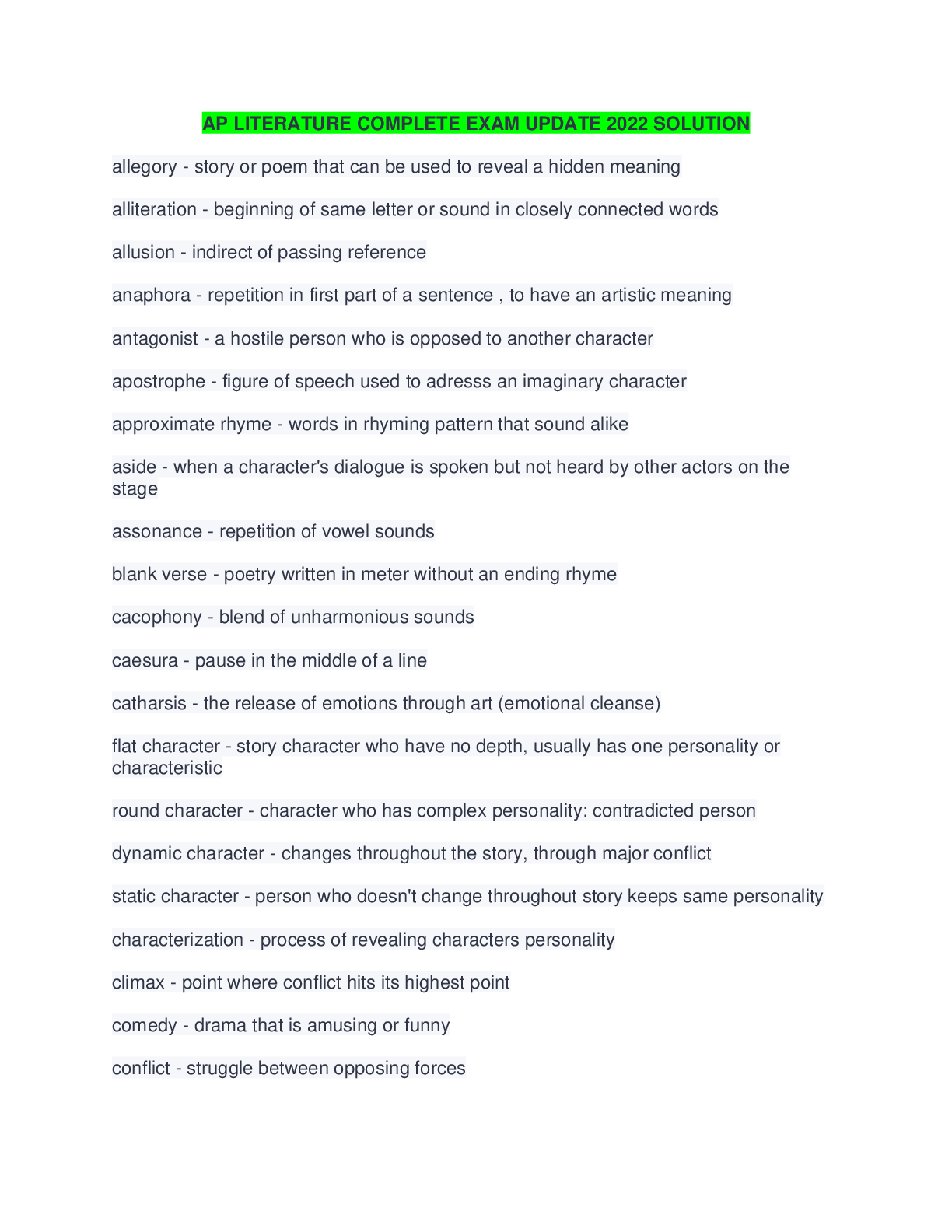
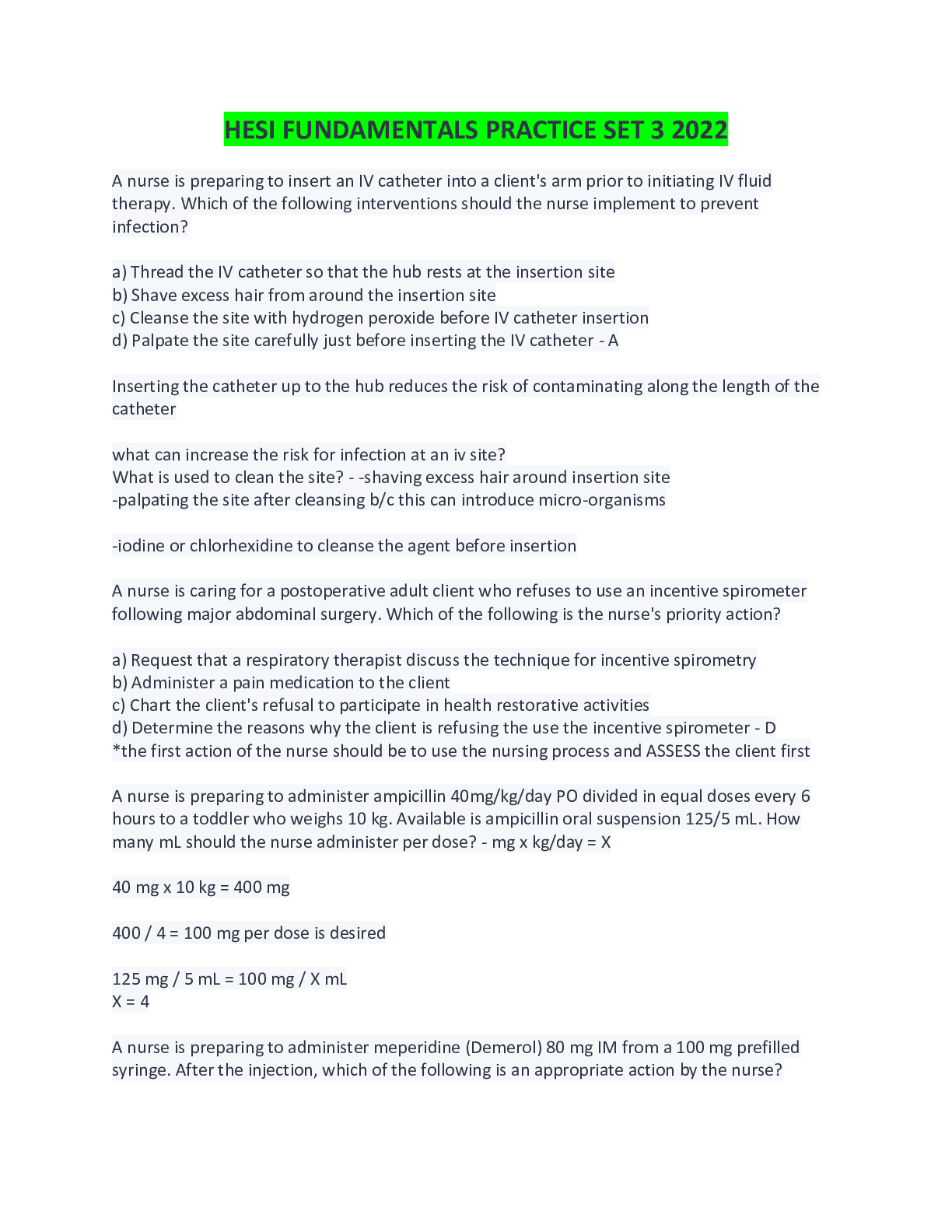
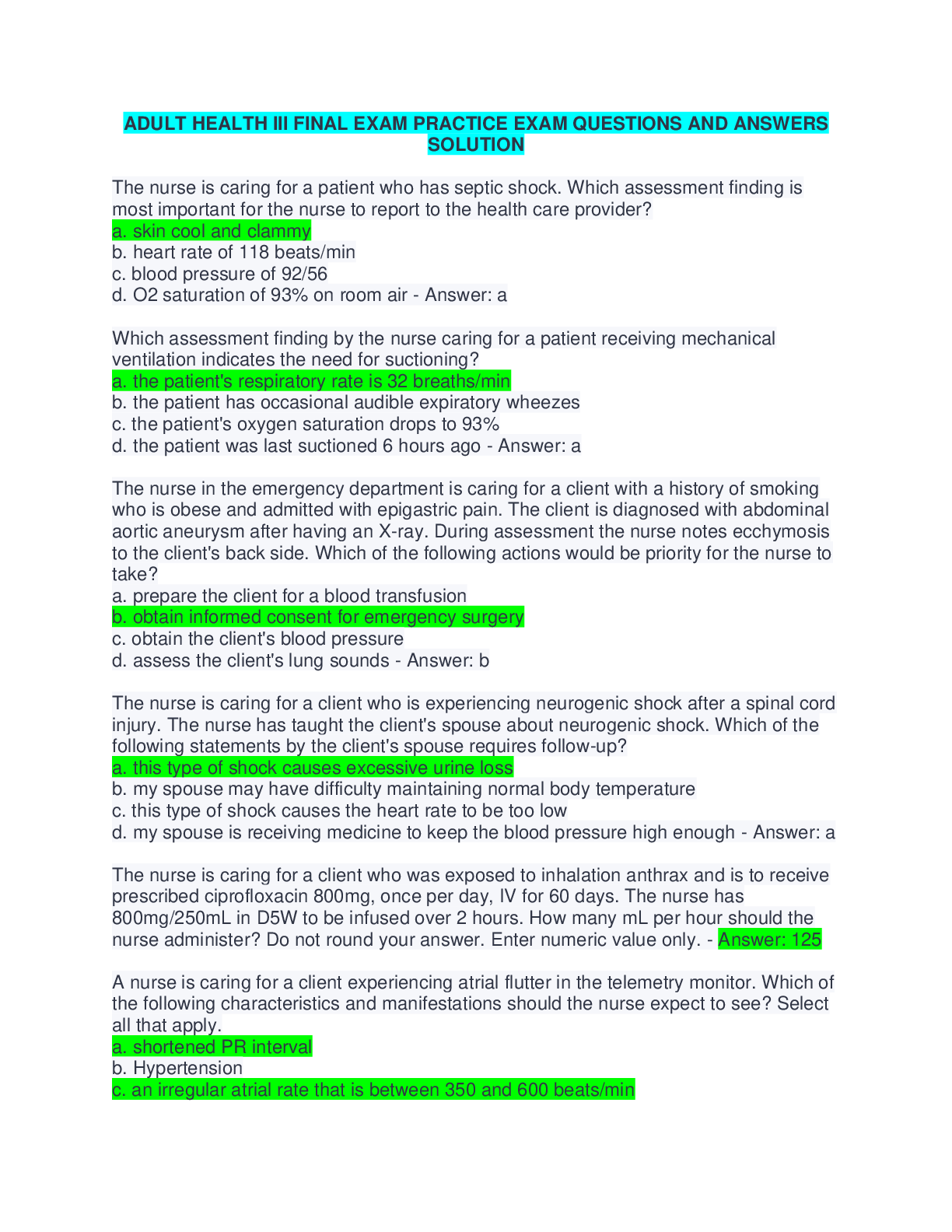

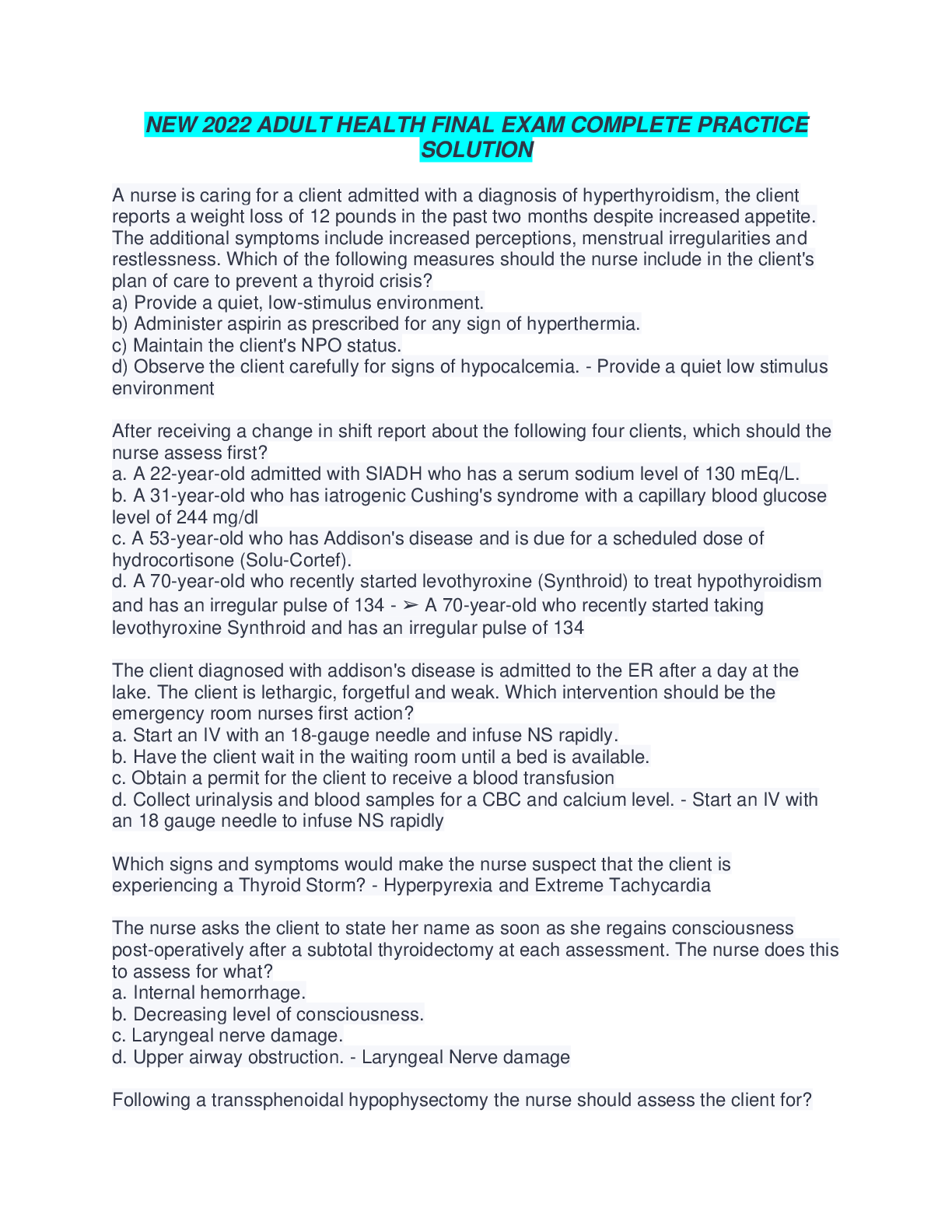
 GRADED QUESTIONS AND ANSWERS.png)
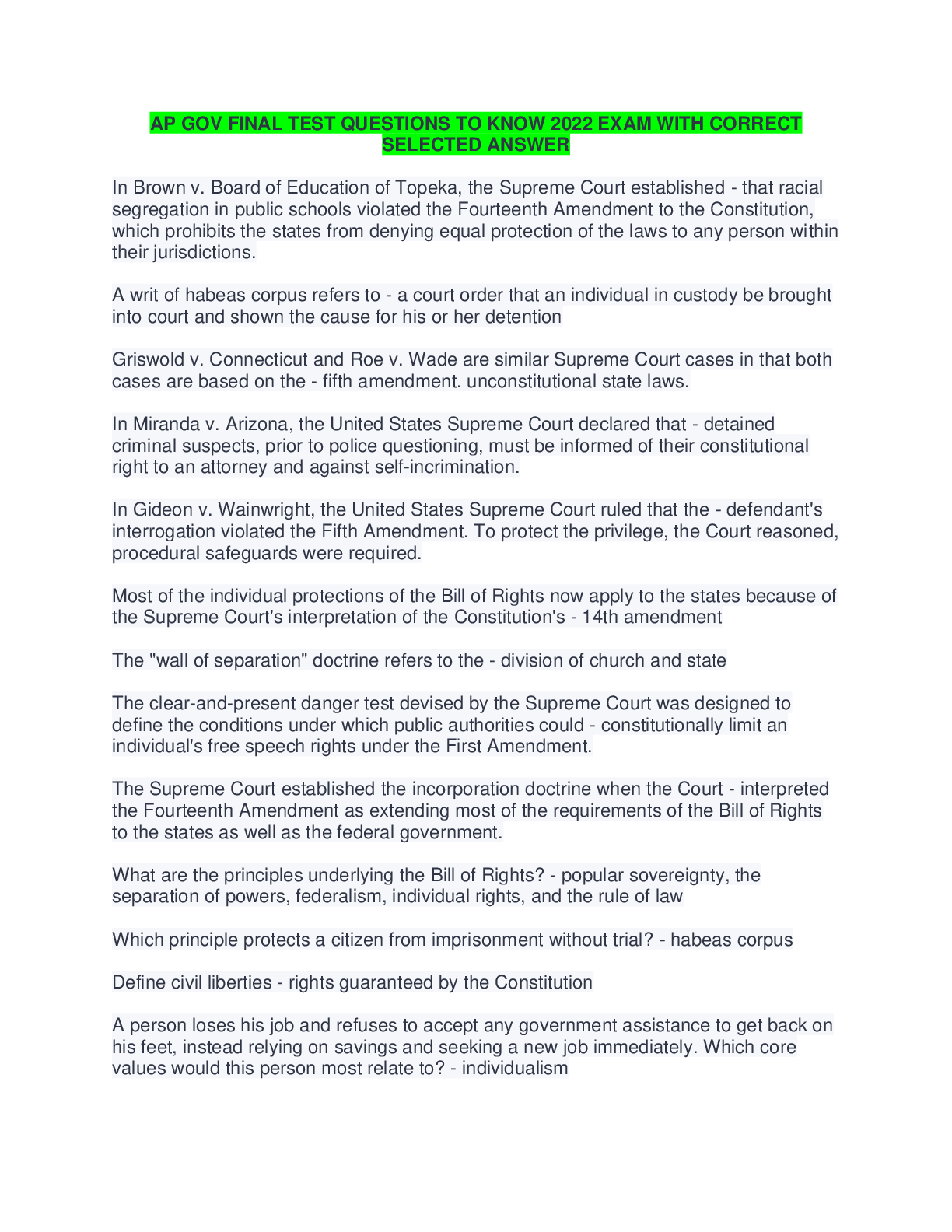
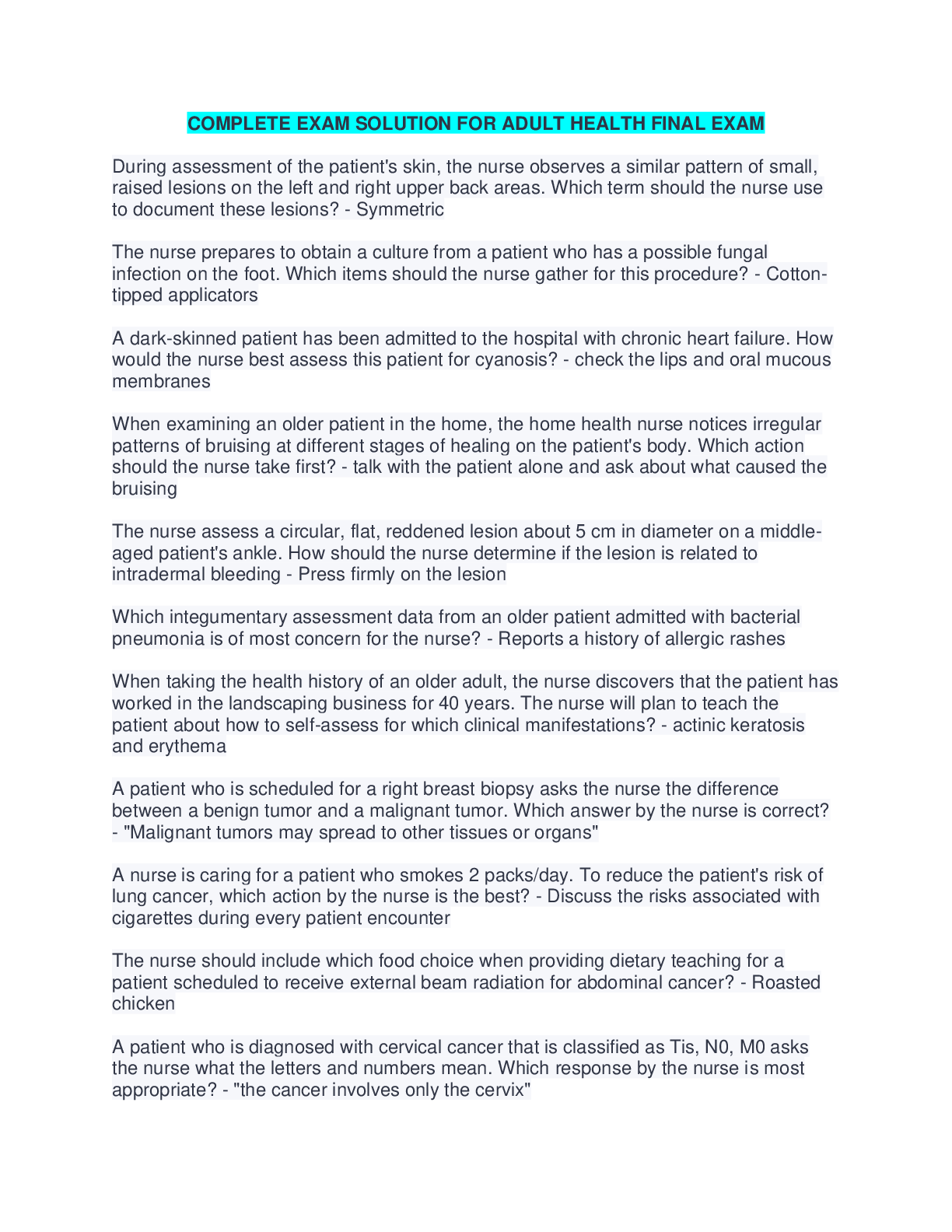
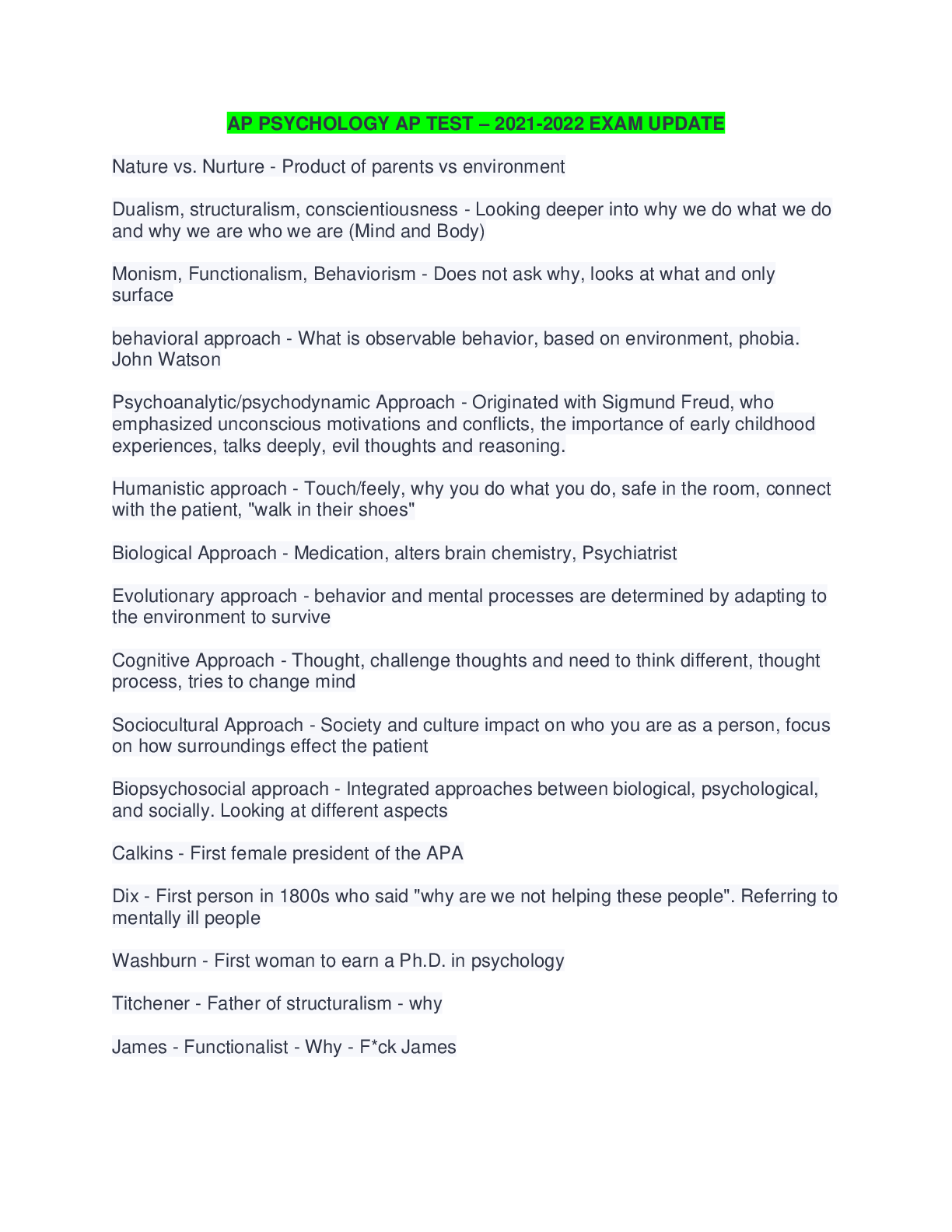



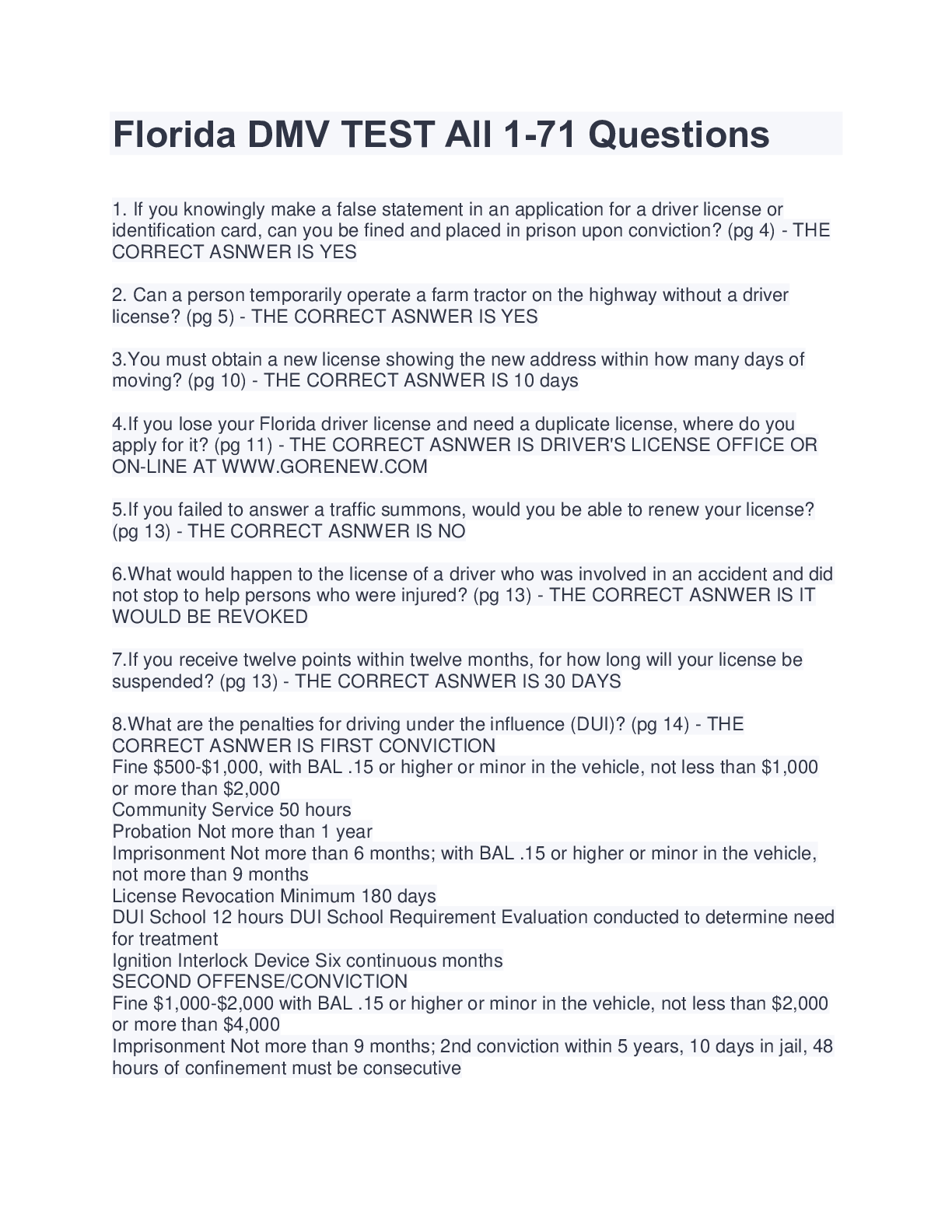
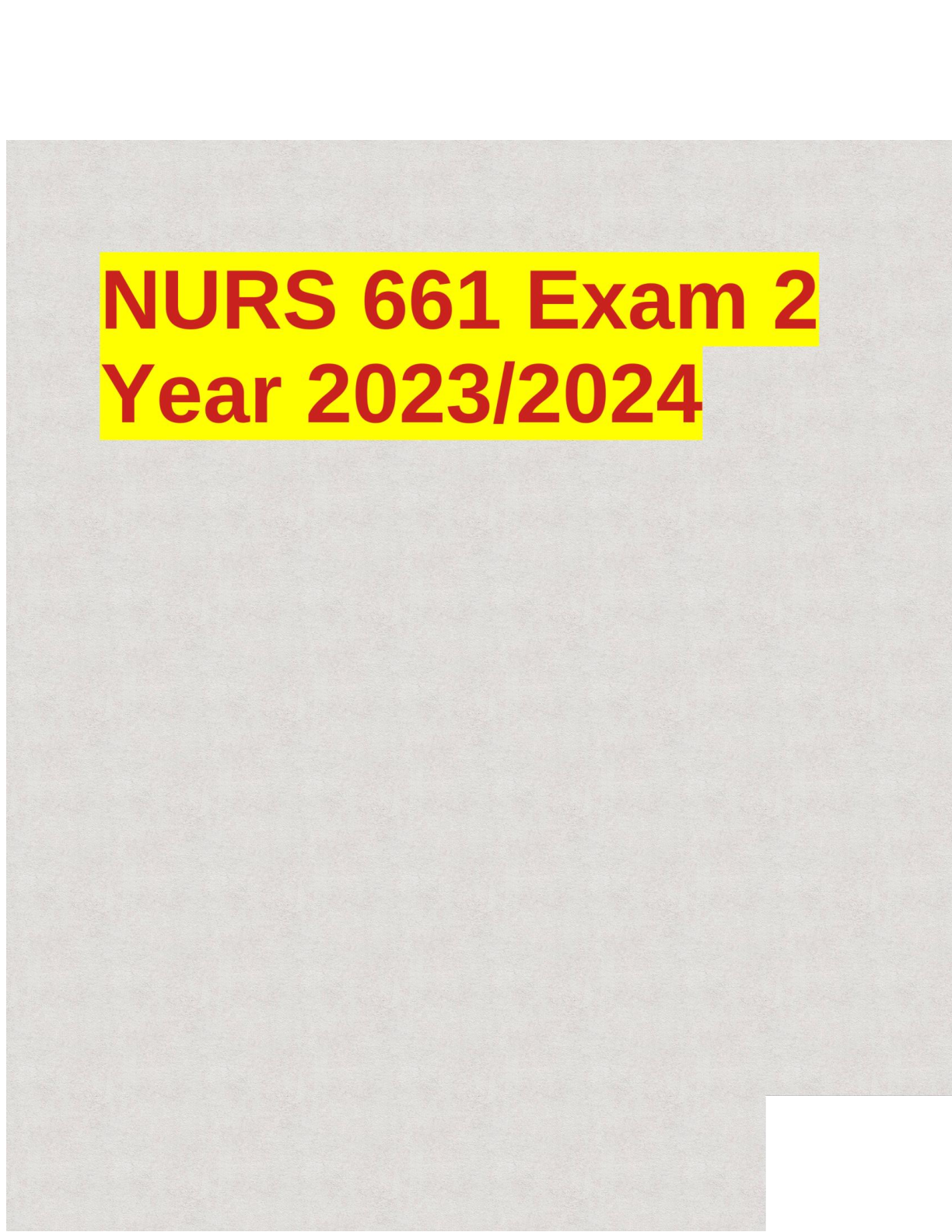

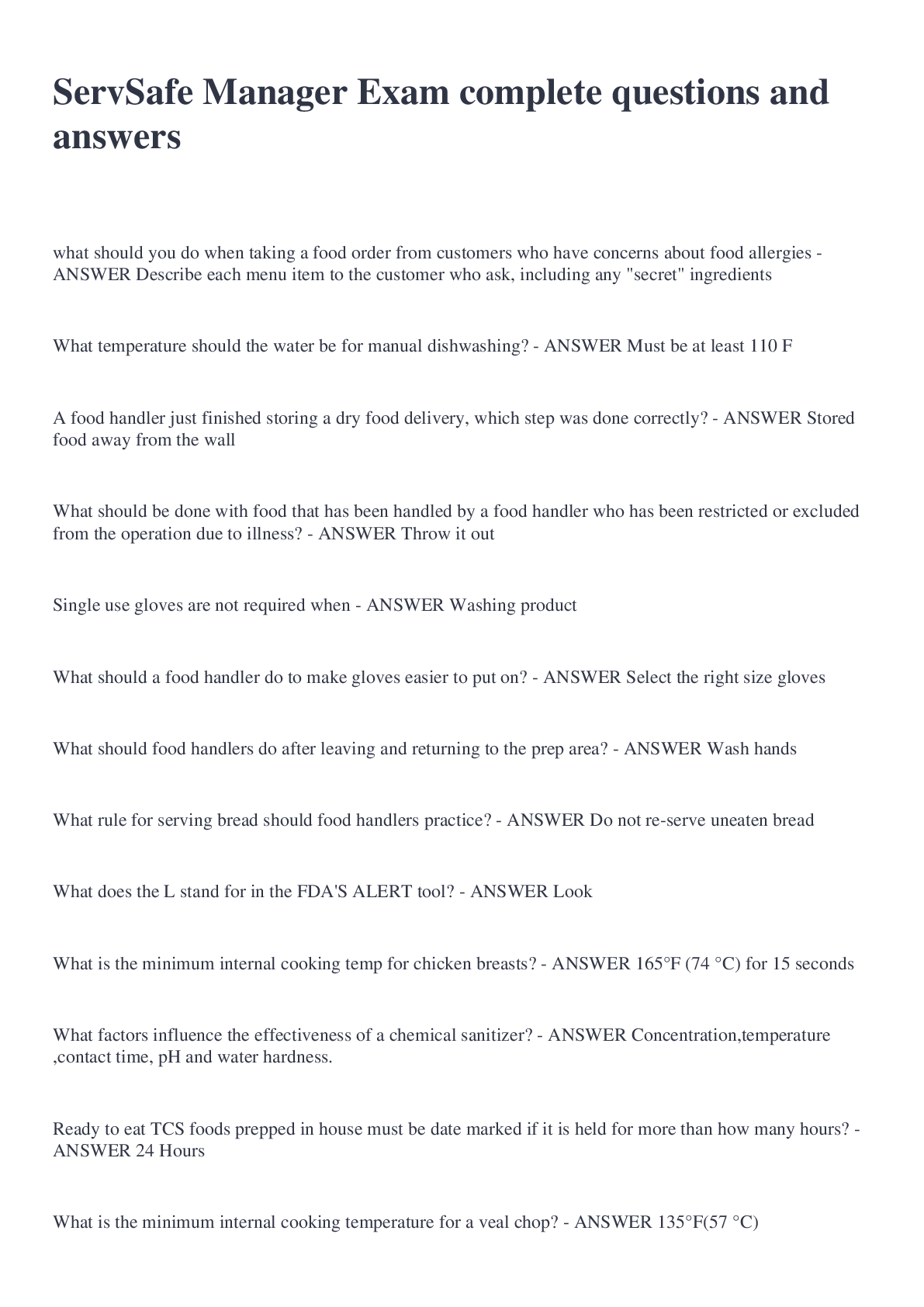


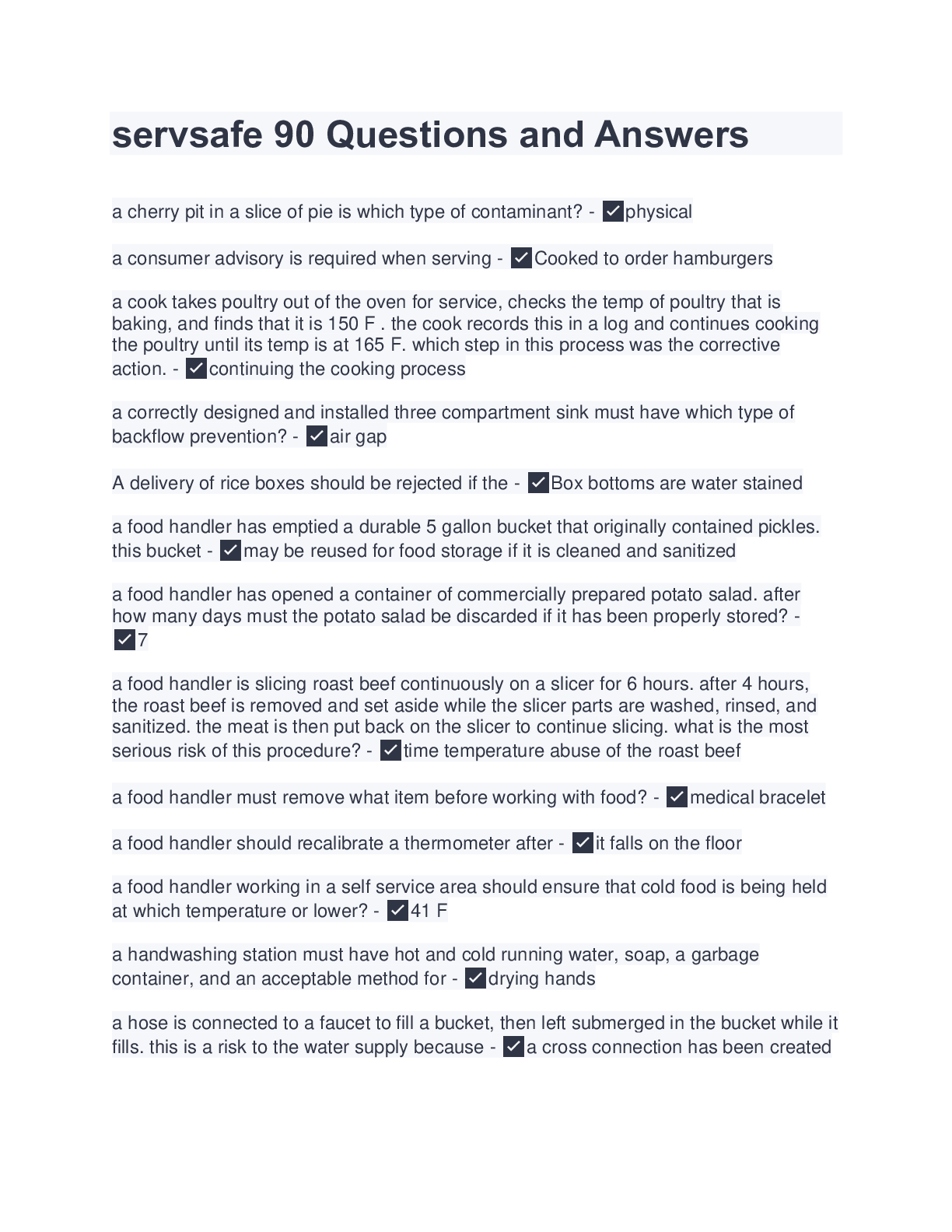
.png)


